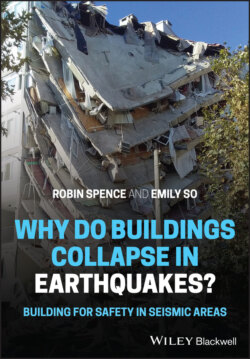Читать книгу Why do buildings collapse in earthquakes? Building for safety in seismic areas - Robin Spence - Страница 16
2 How Do Buildings Behave in Earthquakes? 2.1 Learning from Earthquakes
ОглавлениеWhen a large earthquake occurs, it causes human casualties, damages buildings and infrastructure, and affects livelihoods, society and the wider economy. It also sets in motion a process of relief and recovery, damage assessment and then rebuilding, carried out by governments, NGOs, commercial firms and individual households. It is important that the experience of each earthquake is recorded in detail, and that the lessons learnt are identified and passed on, both for the benefit of the affected country in its attempt to improve preparation for subsequent earthquakes, and also for the international community. Much of the damage caused by an earthquake is visible only for a short time, because demolition and rebuilding often start within a few days, so it is important that damage investigations start rapidly after an event. But it is equally important that, if they are to be useful for international comparison, such investigations should be done in a systematic way.
The need for speedy but systematic post‐earthquake investigations has led to the formation of a number of international earthquake reconnaissance teams whose aim is to be available for rapid deployment after an earthquake. They are composed of earthquake specialists from different disciplines, and generally include team members from the affected country. Each team conducts a survey whose exact scope depends on the scale and type of damage. But the study generally includes investigations of the seismological and geotechnical aspects of the event, the damage to buildings and to infrastructure, and the way in which relief and rescue has been conducted. On return, the team produces a report which is available to all who are interested, and is commonly made available on openly accessible websites. The team also communicates the findings through various technical meetings.
The Learning from Earthquakes programme of the California‐based Earthquake Engineering Research Institute (EERI) has the most experience of such field reconnaissance missions, and has conducted more than 150 investigations since it began after the 1971 San Fernando, California earthquake. In the United Kingdom, the Earthquake Engineering Field Investigation Team (EEFIT), working in conjunction with the UK's Institution of Structural Engineers, has conducted more than 30 investigations since its formation in 1982 following the Irpinia (Italy) earthquake of 1980. Similar organisations exist in several other countries (Spence 2014). The cumulative findings of the missions have been very influential in formulating research programmes which have studied aspects of the physical damage, response and recovery from multiple events. And these research programmes in turn have led to steady improvements of national and international codes of practice for building, as well as assisting in understanding the vulnerability of different types of affected facilities and in developing ways to enhance earthquake safety internationally (EERI 1986; Spence 2014).
Both authors have been involved with several EEFIT post‐earthquake reconnaissance missions. Our direct knowledge of the types of buildings affected in earthquakes, and our understanding of their behaviour, is largely derived from these earthquake missions, as well as from some more detailed field investigations and household surveys carried out independently. The following sections give brief accounts of 10 of the most significant earthquakes of the last 20 years, partly based on our own observations, but also making use of the field reports of our colleagues in the EERI and EEFIT teams and other reports. As we are concerned in this book primarily with buildings, these brief accounts emphasise in particular the range of building types which were affected and the levels and types of damage caused, topics which we will return to look at in more detail later in the book. They also touch, where appropriate, on the methods of damage investigation used.
Table 2.1 lists the most significant events of the twenty‐first century up to 2018. It includes all those events which, according to the EM‐DAT database, killed more than 4000 people, and also all those which had a damage cost exceeding US$3.9bn. The 10 events briefly described here include the 9 events with the highest casualty tolls of the last 20 years, and one other event, the New Zealand Christchurch event of 2011. This was particularly significant not for its casualties, which were relatively low, but for the very high financial cost of the damage caused, and for its particular impact on the historic masonry buildings of the city of Christchurch.
The chapter concludes with some general observations about earthquake damage, an assessment of global damage trends and the distribution of damage between different regions and country groups. In this way, we aim to approach an assessment of the question: how well are we, as an international community, doing in trying to limit the effects of earthquakes for this and future generations?
